Chapter: Introduction to the Design and Analysis of Algorithms : Fundamentals of the Analysis of Algorithm Efficiency
Asymptotic Notations and Basic Efficiency Classes
Asymptotic
Notations and Basic Efficiency Classes
1. Informal Introduction
2. O-notation
3. Omagha -notation
4. 0-notation
5. Useful Property Involving the Asymptotic
Notations
6. Using Limits for Comparing Orders of Growth
7. Basic Efficiency Classes
8. Exercises
As
pointed out in the previous section, the efficiency analysis framework
con-centrates on the order of growth of an algorithm’s basic operation count as
the principal indicator of the algorithm’s efficiency. To compare and rank such
orders of growth, computer scientists use three notations: O (big oh), (big omega), and (big
theta). First, we introduce these notations informally, and then, after
sev-eral examples, formal definitions are given. In the following discussion, t (n) and g(n)
can be
any nonnegative functions defined on the set of natural numbers. In the context we are interested in,
t (n) will be an algorithm’s running
time (usually indicated by its basic operation count C(n)), and g(n) will be some simple function to
compare the count with.
Informal
Introduction
Informally,
O(g(n)) is the set of all functions with
a lower or same order of growth as g(n) (to within
a constant multiple, as n goes to
infinity). Thus, to give a few examples, the following assertions are all true:

Indeed,
the first two functions are linear and hence have a lower order of growth than g(n) = n2, while the last one is quadratic
and hence has the same order of growth as n2. On the
other hand,

Indeed,
the functions n3 and
0.00001n3 are both
cubic and hence have a higher order of growth than n2, and so has the fourth-degree
polynomial n4 + n + 1.
The
second notation, (g(n)), stands for the set of all
functions with a higher or same order of growth as g(n) (to
within a constant multiple, as n goes to
infinity). For example,

Finally, (g(n)) is the
set of all functions that have the same order of growth as g(n) (to within a constant multiple,
as n goes to infinity). Thus, every
quadratic function an2 + bn + c with a > 0 is in (n2), but so are, among infinitely
many others, n2 + sin n and n2 + log n. (Can you
explain why?)
Hopefully,
this informal introduction has made you comfortable with the idea behind the
three asymptotic notations. So now come the formal definitions.
O-notation
DEFINITION
A
function t (n) is said
to be in O(g(n)), denoted t (n) ∈ O(g(n)), if t (n) is bounded above by some
constant multiple of g(n) for all
large n, i.e., if there exist some
positive constant c and some
nonnegative integer n0 such
that
t (n) ≤ cg(n) for
all n ≥ n0.
The
definition is illustrated in Figure 2.1 where, for the sake of visual clarity, n is extended to be a real number.
As an
example, let us formally prove one of the assertions made in the introduction:
100n + 5 ∈ O(n2). Indeed,
100n + 5 ≤ 100n + n (for all
n ≥ 5) = 101n ≤ 101n2.
Thus, as
values of the constants c and n0 required
by the definition, we can take 101 and 5, respectively.
Note that
the definition gives us a lot of freedom in choosing specific values for
constants c and n0. For example, we could also
reason that
100n + 5 ≤ 100n + 5n (for all
n ≥ 1) = 105n
to
complete the proof with c = 105 and n0 = 1.
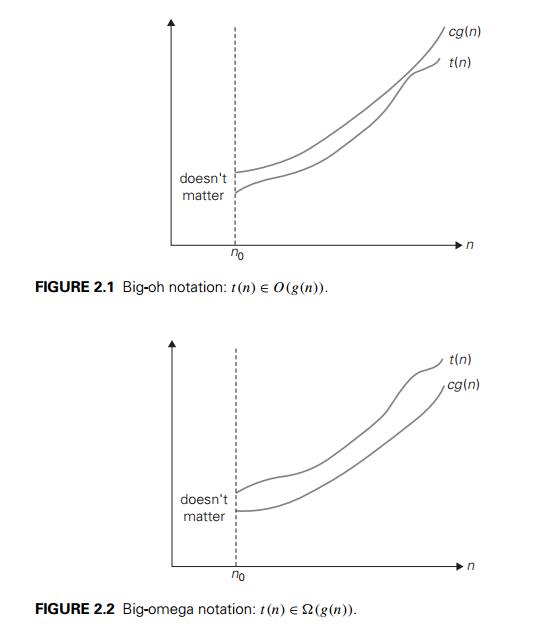
Ω-notation
DEFINITION
A
function t (n) is said
to be in (g(n)), denoted t (n) ∈ (g(n)), if t (n) is
bounded below by some positive constant multiple of
g(n) for all large n, i.e., if
there exist some positive constant c and some
nonnegative integer n0 such
that
t (n) ≥ cg(n) for
all n ≥ n0.
The
definition is illustrated in Figure 2.2.
Here is
an example of the formal proof that n3 ∈ (n2):
n3 ≥ n2 for all n ≥ 0,
i.e., we
can select c = 1 and n0 = 0.
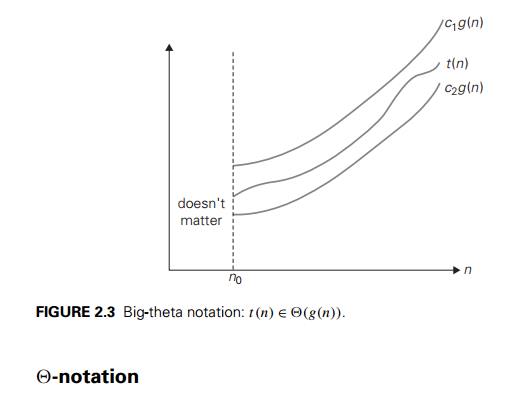
DEFINITION
A
function t (n) is said
to be in (g(n)), denoted t (n) ∈ (g(n)), if t
(n) is bounded both above and below by some positive constant multiples of g(n) for all large n, i.e., if there exist some
positive constants c1 and
c2 and some nonnegative integer n0 such
that
c2g(n) ≤ t
(n) ≤ c1g(n) for all n ≥ n0.
The
definition is illustrated in Figure 2.3.
For
example, let us prove that 21 n(n − 1) ∈ (n2). First, we prove the right inequality
(the upper bound):

Second,
we prove the left inequality (the lower bound):

Useful
Property Involving the Asymptotic Notations
Using the
formal definitions of the asymptotic notations, we can prove their general
properties (see Problem 7 in this section’s exercises for a few simple
examples). The following property, in particular, is useful in analyzing
algorithms that comprise two consecutively executed parts.
THEOREM If t1(n) ∈ O(g1(n)) and t2(n) ∈ O(g2(n)), then
t1(n) + t2(n) ∈ O(max{g1(n), g2(n)}).
(The
analogous assertions are true for the and notations as well.)
PROOF The proof extends to orders
of growth the following simple fact about
four
arbitrary real numbers a1, b1, a2, b2: if a1 ≤ b1 and a2 ≤ b2, then a1 + a2 ≤ 2 max{b1, b2}.
Since t1(n) ∈ O(g1(n)), there exist some positive
constant c1 and some
non-negative integer n1 such
that
t1(n) ≤ c1g1(n) for
all n ≥ n1.
Similarly,
since t2(n) ∈ O(g2(n)),
t2(n) ≤ c2g2(n) for
all n ≥ n2.
Let us
denote c3 = max{c1, c2} and consider n ≥ max{n1, n2} so that we can use both
inequalities. Adding them yields the following:
t1(n) + t2(n) ≤ c1g1(n) + c2g2(n)
c3g1(n) + c3g2(n) = c3[g1(n) + g2(n)]
c32 max{g1(n), g2(n)}.
Hence, t1(n) + t2(n) ∈ O(max{g1(n), g2(n)}), with
the constants c and n0 required
by the O definition being 2c3 = 2 max{c1, c2} and max{n1, n2}, respectively.
So what
does this property imply for an algorithm that comprises two consec-utively
executed parts? It implies that the algorithm’s overall efficiency is
deter-mined by the part with a higher order of growth, i.e., its least
efficient part:

For
example, we can check whether an array has equal elements by the following
two-part algorithm: first, sort the array by applying some known sorting
algorithm; second, scan the sorted array to check its consecutive elements for
equality. If, for example, a sorting algorithm used in the first part makes no
more than 21 n(n − 1)
comparisons (and hence is in O(n2)) while the second part makes no
more than n − 1
comparisons (and hence is in O(n)), the
efficiency of the entire algorithm will be
in O(max{n2, n}) = O(n2).
Using
Limits for Comparing Orders of Growth
Though the formal definitions of O, ѳ, and Ω are indispensable for proving their abstract properties, they are rarely used for comparing the orders of growth of two specific functions. A much more convenient method for doing so is based on computing the limit of the ratio of two functions in question. Three principal cases may arise:
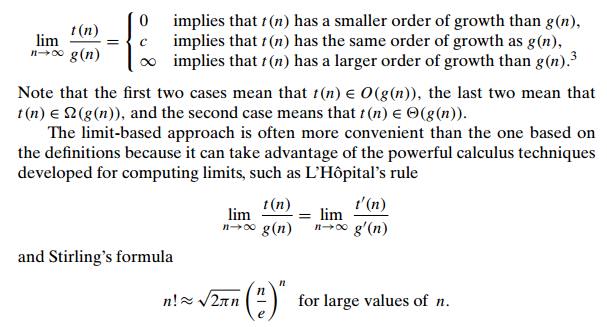
Here are
three examples of using the limit-based approach to comparing orders of growth
of two functions.
EXAMPLE 1 Compare
the orders of growth of 21 n(n − 1) and n2. (This is one of the
examples we used at the beginning of this section to illustrate the
definitions.)

Since the limit is equal to a positive constant, the functions have the same order of growth or, symbolically, 21 n(n − 1) ∈ ѳ(n2).
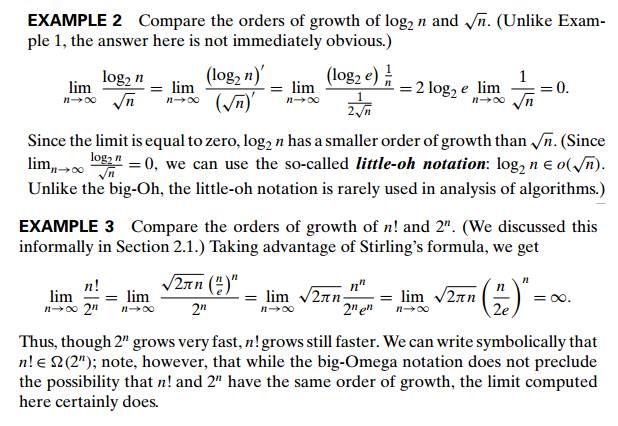
Thus, though 2n grows very fast, n! grows still faster. We can write symbolically that n! ∈ Ω (2n); note, however, that while the big-Omega notation does not preclude the possibility that n! and 2n have the same order of growth, the limit computed here certainly does.
Basic
Efficiency Classes
Even
though the efficiency analysis framework puts together all the functions whose
orders of growth differ by a constant multiple, there are still infinitely many
such classes. (For example, the exponential functions an have
different orders of growth for different values of base a.) Therefore, it may come as a
surprise that the time efficiencies of a large number of algorithms fall into
only a few classes. These classes are listed in Table 2.2 in increasing order
of their orders of growth, along with their names and a few comments.
You could raise a concern that classifying algorithms by their asymptotic effi-ciency would be of little practical use since the values of multiplicative constants are usually left unspecified. This leaves open the possibility of an algorithm in a worse efficiency class running faster than an algorithm in a better efficiency class for inputs of realistic sizes. For example, if the running time of one algorithm is n3 while the running time of the other is 106n2, the cubic algorithm will outperform the quadratic algorithm unless n exceeds 106. A few such anomalies are indeed known. Fortunately, multiplicative constants usually do not differ that drastically. As a rule, you should expect an algorithm from a better asymptotic efficiency class to outperform an algorithm from a worse class even for moderately sized inputs. This observation is especially true for an algorithm with a better than exponential running time versus an exponential (or worse) algorithm.
Exercises 2.2
Use the most appropriate notation among O, Ω, and ѳ and to indicate the time efficiency class of sequential search (see Section 2.1)
in the worst case.
in the best case.
in the average case.
Use the informal definitions of O, Ω, and ѳ to determine whether the follow-ing assertions are true or false.
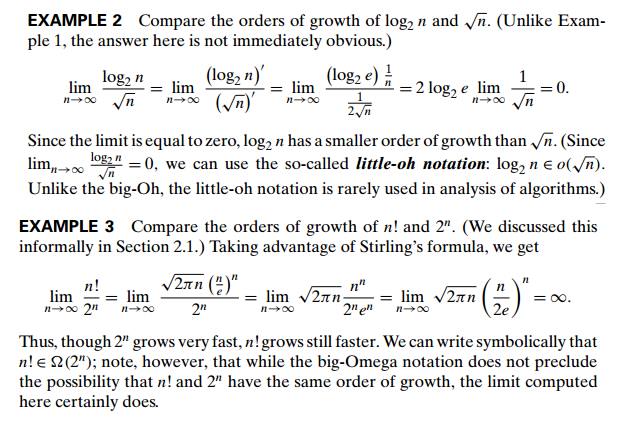
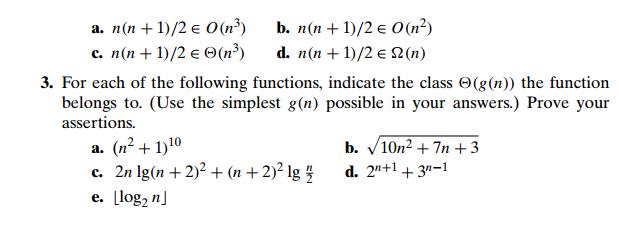
4 a. Table 2.1 contains values of several functions that often arise in the analysis of algorithms. These values certainly suggest that the functions

are listed in increasing order of their order of growth. Do these values prove this fact with mathematical certainty?
Prove that the functions are indeed listed in increasing order of their order of growth.
5 List the following functions according to their order of growth from the lowest to the highest:

b.Prove that exponential functions a-power(n) have different orders of growth for different values of base a > 0.
7 Prove the following assertions by using the definitions of the notations in-volved, or disprove them by giving a specific counterexample.

8 Prove the section’s theorem for
a. ѳ notation. b. Ωnotation.
9 We mentioned in this section that one can check whether all elements of an array are distinct by a two-part algorithm based on the array’s presorting.
If the presorting is done by an algorithm with a
time efficiency in (n log n), what will be a time-efficiency
class of the entire algorithm?
If the sorting algorithm used for presorting needs
an extra array of size n, what
will be the space-efficiency class of the entire algorithm?
10 The range of a finite nonempty set of n real numbers S is defined as the differ-ence between the largest and smallest elements of S. For each representation of S given below, describe in English an algorithm to compute the range. Indi-cate the time efficiency classes of these algorithms using the most appropriate notation (O, Ω, or ѳ).
An unsorted array
A sorted array
A sorted singly linked list
A binary search tree
11 Lighter or heavier? You have n > 2 identical-looking coins and a two-pan balance scale with no weights. One of the coins is a fake, but you do not know whether it is lighter or heavier than the genuine coins, which all weigh the same. Design a (1) algorithm to determine whether the fake coin is lighter or heavier than the others.
12 Door in a wall You are
facing a wall that stretches infinitely in both direc-tions. There is a door in
the wall, but you know neither how far away nor in which direction. You can see
the door only when you are right next to it. De-sign an algorithm that enables
you to reach the door by walking at most O(n) steps
where n is the (unknown to you) number
of steps between your initial position and the door. [Par95]
Related Topics